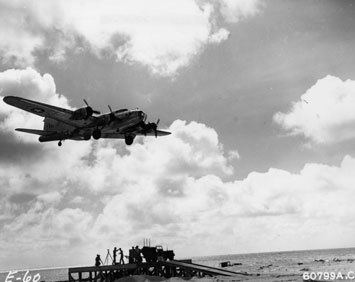Place of origin United States | In service 1944 | |
 | ||
Type Radio-controlled bombers as guided missiles Guidancesystem Azon (TV sensor, radio control)Castor (radar & TV sensors, radio control) | ||
Aphrodite and Anvil were the World War II code names of United States Army Air Forces and United States Navy operations to use B-17 and PB4Y bombers as precision-guided munitions against bunkers and other hardened/reinforced enemy facilities, such as those targeted during Operation Crossbow.
Contents
The plan called for B-17 aircraft that had been taken out of operational service: various nicknames existed such as "robot", "baby", "drone" or "weary Willy" – to be loaded to capacity with explosives, and flown by radio control into bomb-resistant fortifications such as German U-boat pens and V-weapon sites.
It was hoped that it would match the British success with Tallboy and Grand Slam ground penetration bombs but the project was dangerous, expensive and unsuccessful. Of 14 missions flown, none resulted in the successful destruction of a target. Many aircraft lost control and crashed or were shot down by flak, and many pilots were killed. However, a handful of aircraft scored near misses. One notable pilot death was that of Joseph P. Kennedy, Jr., the elder brother of future US President John F. Kennedy.
The program effectively ceased on January 27, 1945 when General Spaatz sent an urgent message to Doolittle: "Aphrodite babies must not be launched against the enemy until further orders".
Proposal
By late 1943, General Henry H. Arnold had directed Brigadier General Grandison Gardner's electronic engineers at Eglin Field, Florida, to outfit war-weary bombers with automatic pilots so that they could be remotely controlled. The plan was first proposed to Major General James H. Doolittle some time in 1944. Doolittle approved the plan for Operation Aphrodite on June 26, and assigned the 3rd Bombardment Division with preparing and flying the drone aircraft, which was to be designated BQ-7. In the U.S. Navy's similar project, Operation Anvil, the drone was designated BQ-8.
Final assignment of responsibility was given to the 562nd Bomb Squadron at RAF Honington in Suffolk. Similarly, on July 6, 1944 the US Navy Special Attack Unit (SAU-1) was formed under ComAirLant, with Commander James A. Smith, Officer in Charge, for transfer without delay to Commander Fleet Air Wing 7 in Europe to attack German V-1 and V-2 sites with PB4Y-1s converted to assault drones.
Procedure
Old Boeing B-17 Flying Fortress bombers were stripped of all normal combat armament and all other non-essential gear (armor, guns, bomb racks, transceiver, seats, etc.), relieving about 12,000 lb (5,400 kg) of weight. To allow easier exit when the pilot and co-pilot were to parachute out, the canopy was removed. Azon radio remote-control equipment was added, with two television cameras fitted in the cockpit to allow a view of both the ground and the main instrumentation panel to be transmitted back to an accompanying CQ-17 'mothership'.
The drone was loaded with explosives weighing more than twice that of a B-17's normal bomb payload. The British Torpex used for the purpose was itself 50% more powerful than TNT.
A relatively remote location in Norfolk, RAF Fersfield, was the launch site. Initially, RAF Woodbridge had been selected for its long runway, but the possibility of a damaged aircraft that diverted to Woodbridge for landings colliding with a loaded drone caused concerns. The remote control system was insufficient for safe takeoff, so each drone was taken aloft by a volunteer pilot and a volunteer flight engineer to an altitude of 2,000 ft (600 m) for transfer of control to the CQ-17 operators. After successful turnover of control of the drone, the two-man crew would arm the payload and parachute out of the cockpit. The 'mothership' would then direct the missile to the target.
When the training program was complete, the 562nd Squadron had ten drones and four "motherships".
